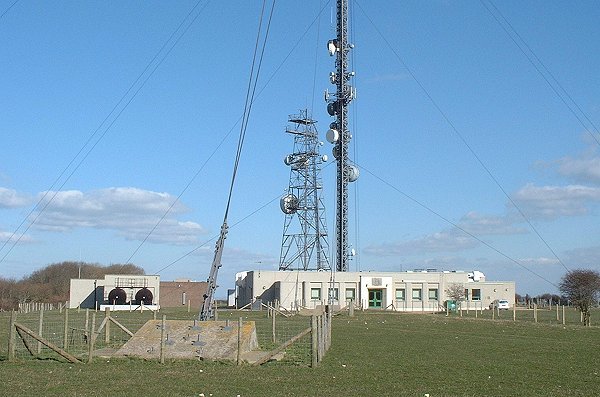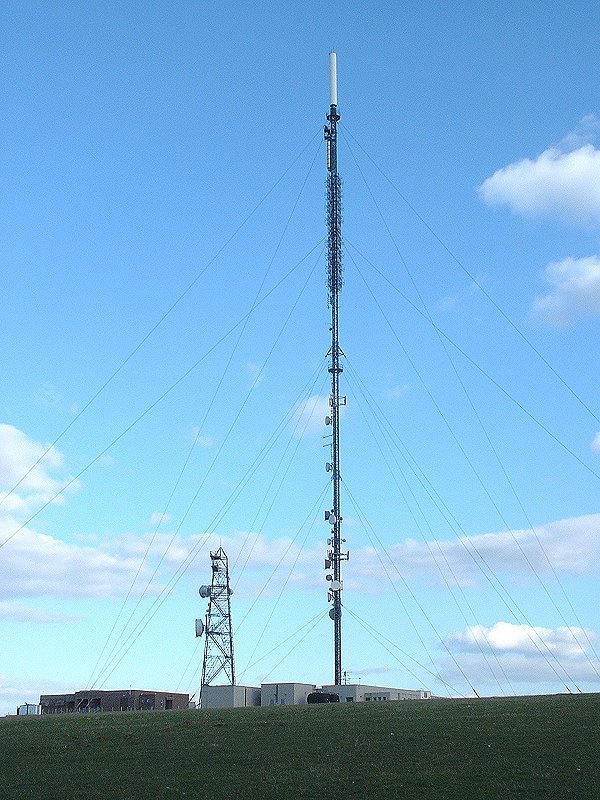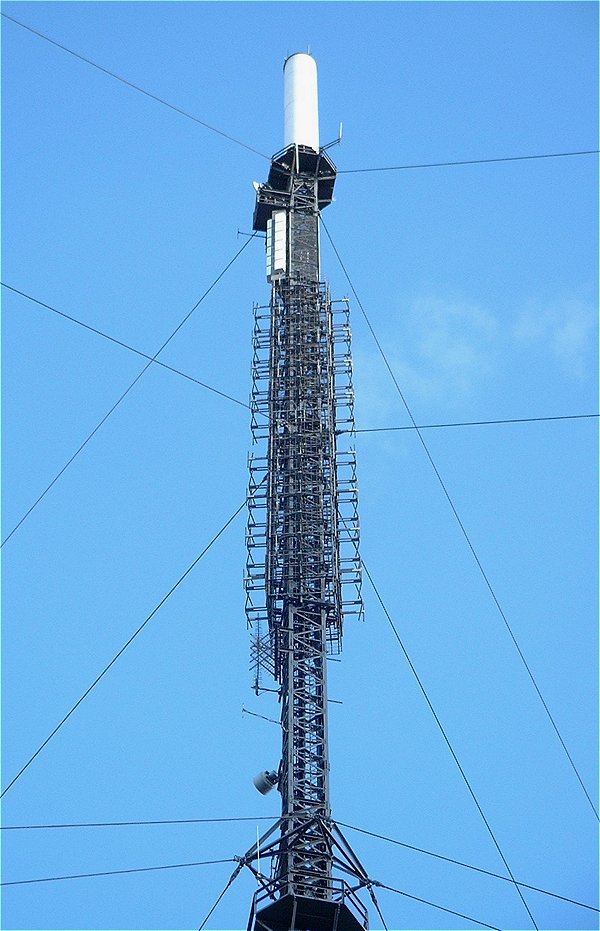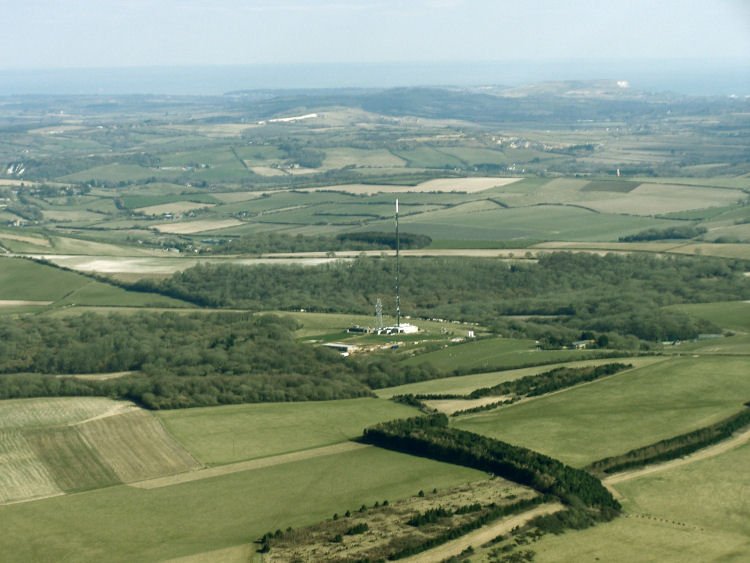 |
UK Broadcast Transmission |
|
|||||||||||
THE TRANSMISSION GALLERY
ROWRIDGE
| Photos by BT Heritage, Ashley Booth, David Foord, Robert Whittaker and George Kirkham | Page last updated: 2020-04-24 |
| This station transmits digital (and previously analogue) television and FM radio to Hampshire and much of the South of England. Links at the bottom of this page lead to BBC research papers pertaining to the choice of Rowridge as the main VHF TV and radio tx site for Central Southern England. Initially the service started on 12th November 1954 from a temporary aerial at 55m. The permanent aerial at 118m mean height, took over the service on 11th June 1956, with the 405 line ch 3 transmitter producing an ERP of 32 kW max. This aerial system comprised of four tiers of single dipoles on the north face of the mast. However continuing perceived shortcomings in the TV service led eventually to modifications and improvements, and two further dipoles were provided on the opposite side of the mast (on tiers 2 and 3) which were driven in such a way to allow the ERP in the desired direction to be increased to 100 kW whilst still protecting the continent from unwanted spillage; the Band I site at Caen Mt Pincon was always a problem both for North Hessary Tor and Rowridge in terms of mutual interference. This ERP increase came into operation in December 1961. At the same time there was also an ERP increase at the co-channel station at Tacolneston, from 18 to 45 kW. The third photo on this page (taken from NNE of the site) shows the final Band I arrangement although one of the dipoles on the north side is hidden by a platform. The 3 BBC FM radio services started from 4th June 1957. Radio Solent first went on air on 31st December 1970 using the BBC network stations aerial. Presumably this site was also chosen as the site for the area's UHF tv transmissions because the taller, slimline mast at nearby Chillerton Down was unable to carry the weight of the aerial panels required. BBC 2 went into service on 16th January 1966, with ITV from 13th December 1969, BBC 1 from 27th December 1969 and Channel 4 available from the start on 2nd November 1982. Analogue Channel 5 for the Southampton area came from Fawley. |

September 1954: the "temporary aerial" referred to above was actually mounted on a 200 ft tower erected by the Post Office. This would also support a dish for the SHF link from Golden Pot (Brockham Hill) carrying the programme feed. According to a Post Office report on the SHF link the main mast subsequently had link dishes at 50 and 75 ft. The yagis at the top of the structure are understood to have been aimed at Wenvoe. (The current BT structure, visible in some of the photos below, was added some time later.)  The above image [TCB 417/E 19530] is Copyright BT Heritage, licensed under a Creative Commons License and reproduced under the following The above image [TCB 417/E 19530] is Copyright BT Heritage, licensed under a Creative Commons License and reproduced under the following terms |


| The Rowridge site is located at Rowridge Farm, just off the B3401 between Newport and Calbourne on the Isle of Wight |

| ABOVE: this "vintage" photo was taken by Ashley Booth in the early/mid 80s. It shows the familiar GRP cylinder for the UHF aerials, the vertical Band I aerials, the Band II slot aerials and, further down, a stacked pair of Band II log-periodic aerials which were used for receiving the RBL for R2 and R3 from Wrotham. The PCM feed for national radio didn't arrive at Rowridge until 1st August 1980, however in July 1971 an off air feed of Wrotham for Radio 3 in stereo was engineered, and in October 1972 Radio 2 went stereo from Rowridge at the same time as Wrotham inaugurated stereo on this network. It wasn't possible to provide Radio 4 in stereo via an RBL though, due to Rennes St Pern operating on the same frequency as Wrotham Radio 4. The tower in the photo belongs to BT. |

| Above: this photo, taken August 1989, shows the old horizontally polarised Band II slot antennas in place, but the Band I array as seen in Ashley Booth's picture has gone. Instead the first half of the new mixed polarisation Band II is there. Shortly after this picture was taken, the BBC transferred transmission to the new half stack, so they could then remove the slot antennas, and replace with the lower half of the new stack. This work was finally completed in May 1990, when a full and improved service was restored, along with the introduction of Radio 1 FM from 24th June 1990. Later that year on 12th November 1990, Radio Solent was finally converted to stereo. |






| As can be seen, the mixed polarisation Band II aerial is fairly complex, due to the need to make it highly directional. For horizontal polarisation Rowridge had an erp of 60 kW, but agreement was reached in the late 1980s with the French to quadruple the power to a total of 250 kW, provided that a 10 db null was engineered into the HRP in the southern sector to protect the continent. The old slot cylinder for horizontal polarisation had of course been omni directional. |

More recently, in March 2010, Robert Whittaker was able to get some aerial shots... |


Below: as part of the digital switchover Rowridge is getting a new, stronger and taller mast to replace the old one. George Kirkahm took this photo on 19-Sep-2010 and already it looks like the new mast is taller: |

Chillerton Down | Fawley | Tacolneston
Rowridge - A disappointment?
The UHF aerial at Rowridge
Tests on sites for Band I TV Central Southern England
South Hampshire & IOW Television SIte Tests (1950)
South Hampshire & IOW Television Site 2nd Interim Report (1951)
| |
Back to TX Gallery index | TX main index
|